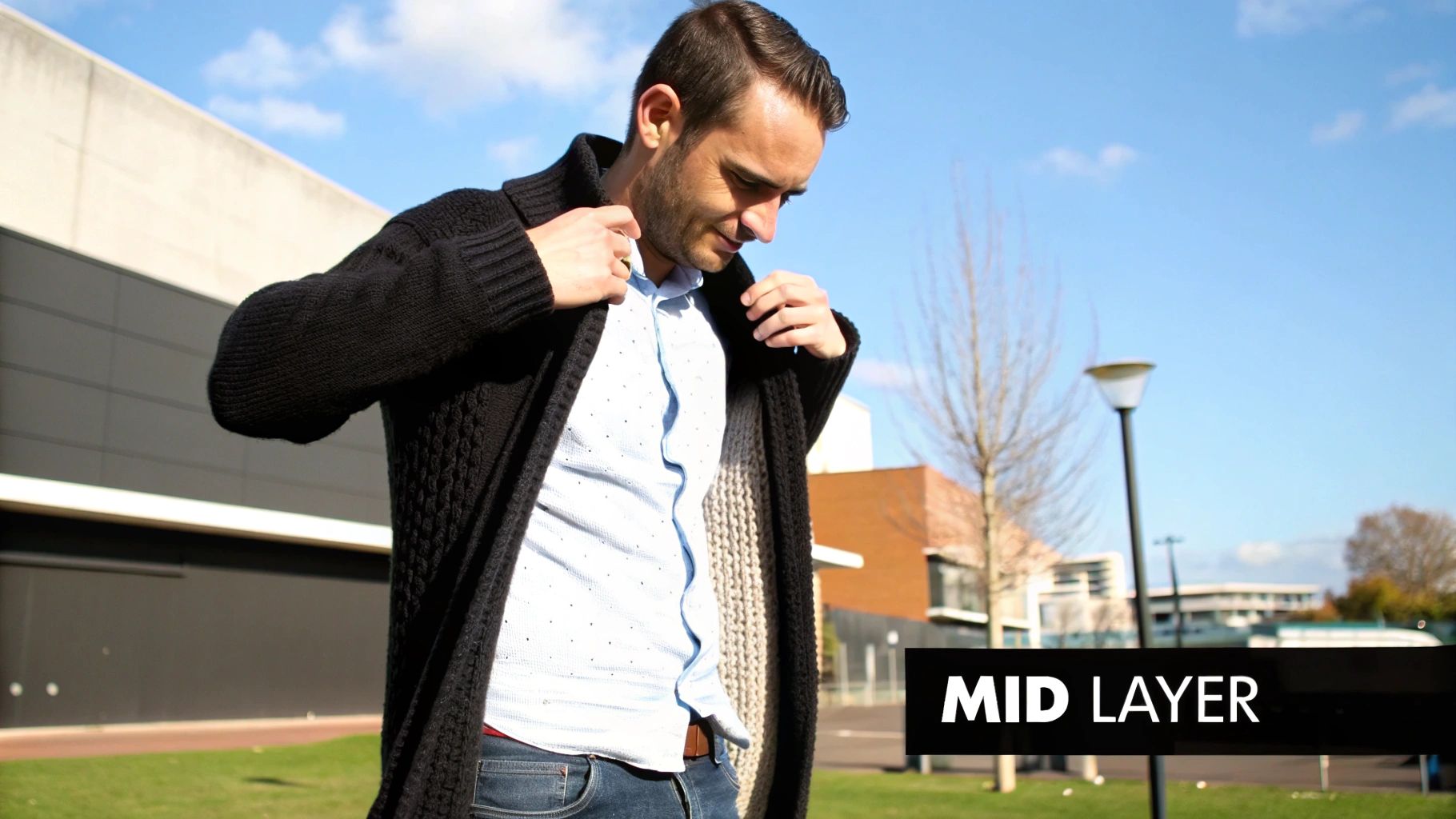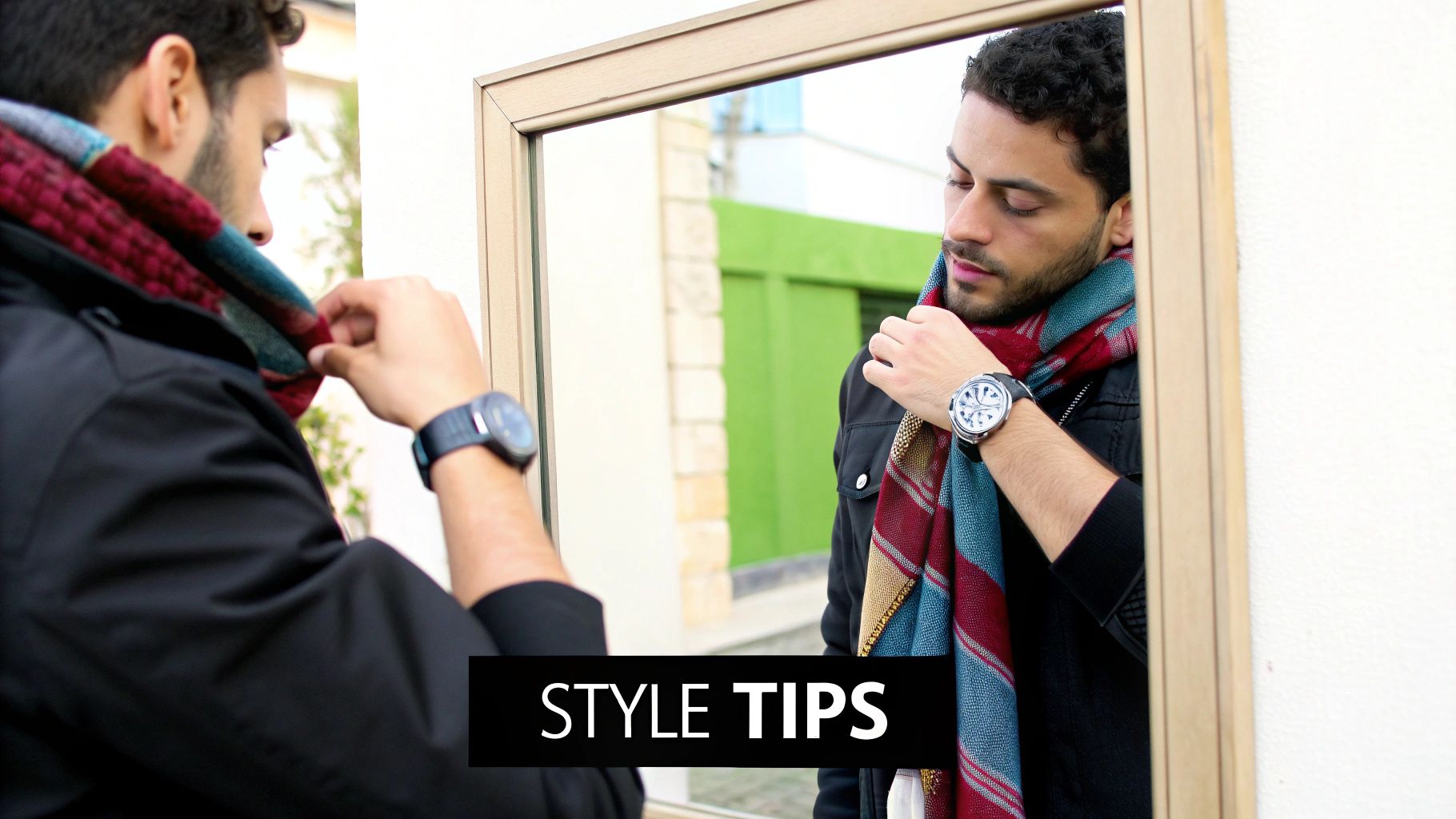How to Layer Clothing Men: Style Tips & Techniques
The Science of Men's Layering: Function Meets Style
Layering isn't just about piling on clothes; it's a strategic way to dress that maximizes both comfort and style. This approach lets men adapt to changing temperatures and activity levels, ensuring they're always just right. Think of it as your personal climate control system. It's about trapping warm air close to your body while allowing sweat and excess heat to escape. This careful balance is the key to staying comfortable, regardless of the conditions.
Layering offers several practical benefits. By creating multiple layers, you trap air between them, forming insulating pockets. These pockets act as a barrier against the cold, similar to insulation in a house. Additionally, proper layering helps manage moisture.
Understanding the Benefits of Layering
Improved insulation and moisture management are two key advantages of layering. The base layer wicks sweat away from your skin, and the outer layers allow it to evaporate. This keeps you dry and comfortable, especially during exercise or changing weather.
For example, imagine hiking on a crisp morning that warms up later. Starting with a moisture-wicking base layer, adding a light fleece mid-layer, and topping it off with a waterproof shell lets you shed layers as needed. This adaptability is essential, particularly for active men. It also makes transitioning from indoors to outdoors seamless, ensuring you're always dressed appropriately.
The Growing Trend of Layering in Men's Fashion
The increasing popularity of layering coincides with significant growth in the men's apparel market. The global menswear market is expected to reach nearly US$937 billion by 2033, growing at a 5.16% compound annual growth rate (CAGR) from 2025 onward. This growth is fueled by factors like urbanization, evolving fashion trends, and rising disposable incomes. Men are investing in versatile layering pieces that offer both style and practicality. For more detailed information, Explore this topic further.
This rising demand reflects a shift towards more thoughtful dressing habits among men. Layering is now seen as a valuable skill. It's not just about function anymore; it's a key element of style. Men increasingly understand the importance of balancing warmth, breathability, and aesthetics in their clothing choices.
Mastering the Three-Layer System: Your Versatile Foundation
The three-layer system is the foundation of effective layering for men, providing adaptable warmth and comfort. Think of it like building a house: a solid foundation (base layer), insulation (mid-layer), and a roof (outer layer). This approach lets you regulate your body temperature in various conditions.

This infographic demonstrates the first step: the base layer. It highlights this often-overlooked garment's importance in managing moisture and maintaining a comfortable body temperature, acting like a second skin. This sets the stage for adding further layers, creating a versatile system.
Base Layer: Moisture Management and Comfort
The base layer is your first defense against the elements, wicking moisture away from your skin. This is crucial for staying dry and comfortable, especially during activity. Materials like merino wool and synthetic fabrics excel at moisture-wicking, offering warmth without bulk. This foundational layer is critical for temperature regulation and overall comfort. Understanding fabric properties is key. For instance, certain oils in natural fibers, like hemp oil, can influence moisture-wicking.
The base layer market is a significant part of men's layering. Valued at approximately USD 7.17 billion in 2024, it’s projected to reach USD 9.18 billion by 2031. This growth is driven by increased participation in sports and outdoor activities, along with the rise of athleisure. Find more statistics here.
To help you choose the right base layer, let's compare some common materials:
Base Layer Material Comparison
This table compares different base layer fabric types for men's layering, highlighting their strengths and weaknesses.
| Material | Moisture-Wicking | Warmth | Odor Resistance | Durability | Best For |
|---|---|---|---|---|---|
| Merino Wool | Excellent | High | Good | Moderate | Hiking, cold weather activities |
| Synthetic (Polyester) | Excellent | Moderate | Excellent | High | Running, high-intensity activities |
| Silk | Good | Low | Moderate | Low | Mild temperatures, layering under dress clothes |
| Cotton | Poor | Moderate | Poor | High | Casual wear, not recommended for high activity |
This comparison reveals key differences. While merino wool provides excellent warmth and good odor resistance, synthetics offer superior durability and moisture-wicking for high-intensity pursuits. Silk is a good choice for milder temperatures while cotton, though comfortable, is less suitable for active wear.
Mid-Layer: Insulation Without the Bulk
The mid-layer provides insulation, trapping warm air close to your body. This layer is your primary source of warmth. Choose materials that balance insulation and breathability. Fleece, down, and lightweight sweaters are excellent options. Adjust the warmth of your outfit based on weather conditions. You might consider integrating graphic tees into your mid-layer strategy.
Outer Layer: Protection From the Elements
The outer layer shields you from wind, rain, and snow. It should be both weather-resistant and breathable, allowing moisture vapor to escape. Consider materials like Gore-Tex or a durable water repellent (DWR) finish for optimal protection. This final layer completes the system, keeping you comfortable and protected, regardless of the weather. Effective layering for men depends on this system for variable conditions.
Seasonal Layering Strategies That Actually Work

This image shows how layering can create adaptable outfits for various temperatures and styles. The goal isn't just to pile on clothes, but to build outfits that adjust to your needs. This section offers practical guides for effective seasonal layering.
Winter Layering: Warmth Without Bulk
Winter layering is all about staying warm without looking bulky. Choosing the right fabrics and understanding how they work together is key. Begin with a moisture-wicking base layer made of merino wool or a synthetic fabric. This will keep you dry and comfortable, even when active.
Next, add a mid-layer for insulation. A lightweight down jacket or a fleece offers warmth without the bulk of a heavy sweater. Your outer layer should be a waterproof, windproof shell for protection from the elements. This outer layer is your shield against harsh winter weather.
Transitional Season Layering: Adapting to Change
Spring and autumn bring unpredictable temperatures. Versatility is essential. Choose layers that can be easily added or removed as the temperature changes. A lightweight jacket, a versatile vest, and a thin sweater are ideal for these seasons. For instance, a quilted vest adds warmth on a cool morning but can be easily taken off as the day gets warmer.
Consider layering with different fabrics. A linen shirt over a t-shirt creates a stylish and breathable layer for a milder spring day. This adaptability keeps you comfortable and stylish all day long. You might also want to check out tips for beachwear: How to master stylish casual beach wear.
Summer Layering: Staying Cool in the Heat
Layering can be useful even in summer, especially in air-conditioned spaces or during cooler evenings. Prioritize lightweight, breathable fabrics like linen, cotton, and chambray. A linen shirt layered over a t-shirt offers a classic summer look. This provides a touch of style while remaining cool and comfortable.
This approach also allows for a smooth transition from day to night. Add a lightweight linen blazer or a thin cardigan for evening occasions. This adds a touch of sophistication to your outfit without sacrificing comfort. The growing market for base layers reflects the increasing demand for functional clothing. In North America and Europe, this market was valued at about $4.91 billion in 2021 and is projected to reach $7.18 billion by 2031. Learn more about base layers here. This trend emphasizes that layering is not just about fashion; it’s about building a wardrobe that works for you.
Body-Conscious Layering: Techniques for Every Build
Layering clothes offers incredible versatility, but standard advice often misses a key element: your body type. This guide breaks down how to layer strategically to enhance your physique, using expert insights from the world of menswear and image consulting.  This image shows how different layering combinations can work with various body shapes. The goal is to create balanced proportions and a silhouette that flatters.
This image shows how different layering combinations can work with various body shapes. The goal is to create balanced proportions and a silhouette that flatters.
Layering for Shorter Frames: Creating Height
For men with shorter frames, the main objective is to create a visual impression of height. This involves highlighting vertical lines and minimizing horizontal breaks. Choose monochromatic color schemes or analogous colors (colors next to each other on the color wheel) to create a streamlined, unbroken vertical line. This helps give the illusion of added height.
Opt for slim-fitting layers to avoid adding extra bulk. Oversized or boxy pieces can overwhelm a shorter frame. V-neck sweaters and button-down shirts worn unbuttoned at the top can also help elongate the torso. For more tips on shirts, check out this guide: How to master the flannel shirt.
Layering for Slender Builds: Adding Structure
Slender builds can benefit from layering that adds structure and dimension. Experiment with textures and patterns to create visual interest and the appearance of more volume. For example, a textured knit sweater over a patterned shirt can add depth to a slim frame.
Playing with different fabric weights can also be effective. A heavier knit sweater over a lighter-weight t-shirt can add shape without looking bulky, creating a more defined silhouette.
Layering for Broader Builds: Balancing Proportions
Layering for broader builds focuses on balance and proportion. Choose layers that fit well, avoiding extremes of too tight or too loose. Structured jackets and coats can help define the shoulders and create a more tailored appearance.
Consider darker colors for outer layers for a slimming effect, using lighter colors for inner layers to add contrast and visual interest. This technique balances proportions and creates a cohesive look.
To help visualize these recommendations, here's a helpful table summarizing layering strategies for different body types:
Layering Recommendations by Body Type
| Body Type | Recommended Base Layers | Ideal Mid Layers | Optimal Outer Layers | Styling Tips |
|---|---|---|---|---|
| Shorter Frame | Slim-fit tees, henleys, v-necks | Lightweight sweaters, cardigans | Fitted jackets, shorter coats | Monochromatic colors, vertical stripes |
| Slender Build | Patterned shirts, textured tees | Knit sweaters, patterned cardigans | Jackets with some structure, textured outerwear | Experiment with textures and patterns |
| Broader Build | Solid color tees, henleys | Lightweight sweaters, vests | Structured jackets, darker color coats | Darker outer layers, lighter inner layers |
This table provides a quick reference for choosing the right layers to flatter your specific body type. Remember, fit and proportion are key to successful layering.
Key Takeaways for Body-Conscious Layering
Here’s a recap of the essential points:
- Understand your body type: This is the foundation of effective layering.
- Create vertical lines: This makes you appear taller, especially helpful for shorter men.
- Manage bulk: Avoid adding too much bulk, especially around the midsection.
- Use textures and patterns strategically: These add depth and visual appeal.
- Choose the right fit: Proper fit is essential for any body shape.
By considering your body type and following these strategies, you can use layering to enhance your physique and create a stylish and flattering look. Layering offers a powerful way to elevate your wardrobe, blending function, comfort, and personal style.
Context-Perfect Layering: From Office to Outdoors
Layering clothes effectively depends heavily on the environment. Just like you wouldn't wear the same outfit for a business meeting and a hike, your layering approach should change too. This section explores how men can layer clothing for different situations, from the office to outdoor adventures.
Layering for the Office: Professional and Comfortable
Balancing professionalism and comfort in an office setting can be tricky. The goal is to look sharp while maintaining ease of movement and adjusting to changing temperatures. Start with a crisp button-down shirt as your base layer. This provides a professional foundation.
Add a lightweight sweater or cardigan as your mid-layer for warmth. Merino wool or cashmere offer luxurious comfort and breathability. A blazer or sports jacket serves as your outer layer, providing structure and a formal touch. This combination allows you to easily adapt to the office climate by adding or removing layers.
Layering for Casual Occasions: Elevated Everyday Style
Casual situations allow for a more relaxed approach to layering. The goal is to elevate your everyday look without seeming overdressed. A simple t-shirt or henley serves as a comfortable base, offering a versatile starting point.
A denim jacket, bomber jacket, or hoodie layered over your base adds warmth and style. This creates a casual yet put-together appearance. For cooler evenings, a lightweight overshirt or shacket provides extra warmth and visual interest.
Layering for Outdoor Adventures: Performance and Style
Outdoor layering prioritizes both performance and protection from the elements. Begin with a moisture-wicking base layer made of merino wool or synthetic material. This will wick sweat away from your skin, keeping you dry and comfortable during activities.
Add a fleece jacket or insulated vest as your mid-layer for warmth. Down or synthetic insulation provides excellent warmth without the bulk. Finally, a waterproof and breathable shell jacket protects you from wind, rain, and snow. This adaptable three-layer system can be adjusted to changing weather conditions.
Layering for Evening Events: Sophisticated and Stylish
Evening events call for a more sophisticated approach to layering. A dress shirt or button-down shirt provides a polished base. A vest or cardigan adds warmth and texture, creating depth and visual interest.
Finally, a blazer or sports coat completes the look, adding a touch of formality and elegance. For colder evenings, a topcoat or overcoat provides extra warmth and style. The choice of fabrics and textures can significantly elevate your evening attire.
Building a Cohesive Layering System
The real skill in layering is creating a versatile wardrobe with pieces that can be mixed and matched for different occasions. Investing in high-quality, adaptable items maximizes your wardrobe's potential. This means focusing on pieces that can serve multiple purposes.
For example, a merino wool sweater can be a mid-layer under a blazer at the office or a standalone piece for a casual outing. A waterproof shell jacket can be used for hiking or as a raincoat for your commute. By building a collection of interchangeable pieces, you can create a wide variety of layered looks for any situation. This approach ensures you're always prepared and stylish, no matter the context.
Investment Layering Pieces: Building Your Arsenal

This image illustrates how investing in key layering pieces can truly elevate your style and allow you to adapt to various situations. Think of it like a home renovation—you might consider updating your kitchen or bathroom to improve functionality and aesthetics. Similarly, your wardrobe benefits from strategic upgrades with essential layering items. Building a versatile and stylish wardrobe isn't about chasing fleeting trends; it's about investing in quality pieces that will last. This section focuses on identifying those cornerstone layering pieces worth your investment.
Base Layers: The Foundation of Comfort
The base layer, often underestimated, is the crucial first step in effective layering. Its primary function is regulating your body temperature and wicking moisture away from your skin. Look for premium materials like merino wool for its natural breathability and odor-resistant properties. High-quality synthetic blends also offer excellent moisture-wicking and durability, particularly beneficial for high-intensity activities.
One way to recognize quality is by checking the fabric's weight and the construction of the seams. Flatlock seams, for example, minimize chafing and maximize comfort. A well-made base layer should feel almost invisible, providing comfort and support without restriction. Investing in a few premium base layers sets the foundation for countless outfits and provides exceptional performance across a range of conditions.
Mid-Layers: Versatile Warmth and Style
Mid-layers are your primary source of insulation. Lightweight down jackets, fleece pullovers, and versatile sweaters are all excellent choices. When choosing a mid-layer, prioritize quality materials and construction. For down jackets, a key factor is fill power, which indicates the down's loft and insulation capacity. A higher fill power translates to more warmth with less weight.
When selecting sweaters, consider natural fibers like cashmere or merino wool for their softness, warmth, and breathability. Small details, like reinforced elbows and cuffs, contribute to the garment's overall durability and longevity.
Outer Layers: Protection and Style
Your outer layer is your shield against the elements. Waterproof and breathable shell jackets are essential for protection from wind, rain, and snow. Look for features like taped seams and adjustable hoods for enhanced performance in challenging weather.
A quality outer layer should be both functional and stylish. Consider the jacket's cut and fit, ensuring it complements your personal style and allows for comfortable layering underneath. Investing in a versatile outer layer that transitions seamlessly from city streets to outdoor adventures maximizes its value and utility.
Building a Capsule Layering Wardrobe
The key to maximizing your investment is creating a capsule wardrobe of layering pieces that can be mixed and matched effortlessly. Choose neutral colors and classic styles that offer maximum versatility. This approach allows you to create a surprising variety of outfits for different occasions and weather conditions.
For instance, a classic navy blazer can be dressed up with a dress shirt and tie or dressed down with a simple t-shirt and jeans. A quality leather jacket adds a touch of rugged style to almost any ensemble. By investing in versatile, high-quality pieces, you'll build a wardrobe that evolves through thoughtful additions, not constant replacements. This strategy delivers superior cost-per-wear value and allows you to cultivate a truly distinctive personal style.
Explore the MAVRICKS collection of graphic tees, hoodies, and hats to build your ideal layering arsenal: Shop now at MAVRICKS and elevate your style and adventure today.
